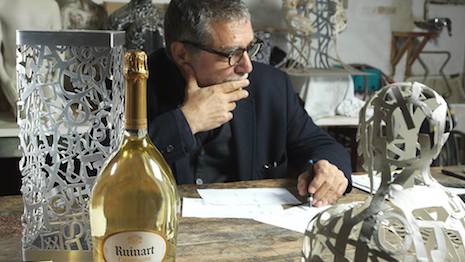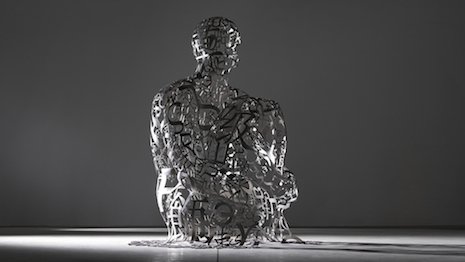 Jaume Plensa for Ruinart
Jaume Plensa for Ruinart
LVMH-owned Champagne house Ruinart is translating its spirit into humanoid form, telling its origin story in a new medium through an art alliance.
The brand’s artist of the year Jaume Plensa took inspiration from the man behind its origins dom Thierry Ruinart, creating a sculpture that is multilingual. Ruinart selects a new artistic collaborator each year, allowing it to gain a new perspective on its own narrative.
By the letter
Dom Thierry Ruinart was a Benedictine monk who resided in the Champagne region of France. He foresaw the popularity of “wine with bubbles” and told his nephew Nicolas Ruinart, who then went on to found the house in 1729.
Mr. Plensa’s work often features human figures looking ahead in a contemplative position His piece for Ruinart continues this tradition, depicting a crouched individual.
Taking reference from the learned author, Mr. Plensa used letters from the Latin, Greek, Arabic, Hebrew, Chinese, Japanese, Russian and Hindi alphabets to construct his stainless steel figure. The artist saw this as taking the monk’s works down to the “cell” of letters and numbers and then putting them back together in a new form.
Jaume Plensa's sculpture for Ruinart
A nod to the man behind the idea for Ruinart, Mr. Plensa includes a root-like base, representing the roots of the grape vines and his own grounding in Champagne. At this base, the artist engraved the dates 1729 and 2016.
In addition to the sculpture, Mr. Plensa created 20 limited-edition boxes for Ruinart. Keeping to the mosaic theme of his works, the boxes crafted by the workshops at Orfèvrerie d’Anjou are see-through, allowing the magnum bottle of Ruinart’s Blanc de Blancs housed inside to be seen.
Ruinart x Jaume Plensa
Every year, the self-proclaimed oldest Champagne house collaborates with an artist, giving them free reign to produce a work that tells the brand’s story in a new way.
Last year, Ruinart is exploring the landscape of its cellars in Reims, France with the help of a photographic eye. The brand tapped Danish multidisciplinary artist Erwin Olaf, who documented the influence of nature and man on the cellars (see story).

